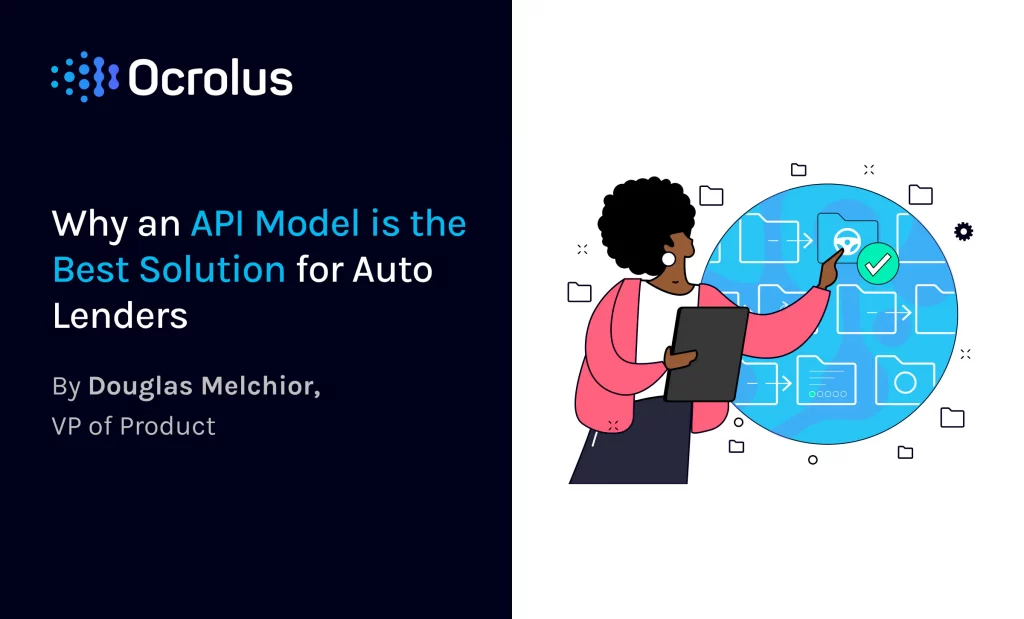This website uses cookies so that we can provide you with the best user experience possible. Cookie information is stored in your browser and performs functions such as recognising you when you return to our website and helping our team to understand which sections of the website you find most interesting and useful.
Why an API Model is the Best Solution for Auto Lenders

When it comes to auto lending, lenders want to be able to make decisions about their borrowers quickly and accurately. However, this can be tricky in an industry that is often bogged down by manual, paper-driven underwriting processes.
One of the most effective solutions for this issue is an application programming interface (API) that bridges a lender’s existing back office system, document processing, and income analysis. An Income Analysis API allows companies to accept income forms on their website, electronically bridge the paper and PDF gap, and immediately verify borrower financial information. While automation can often be intimidating, forward-thinking lenders are shrinking time to close financing by making this process a 100% online, efficient process.
Benefiting from APIs
An API solution can revolutionize an auto lender’s tech stack by facilitating their ability to classify, capture, and analyze financial documents across formats and enabling data sharing within other point of sale and loan origination systems. Best of all, once an API is implemented, no special training is needed to use it.
APIs make extracting information from a document and structuring the data easier. In particular, APIs often replace manual data entry and validation activities. This automation reduces labor-related time and costs, and enables documents to be processed faster and more accurately allowing for a more complete borrower profile.
From a compliance perspective, APIs can help automate the validation process. An API can, for example, detect everything from file tampering and incomplete data sets to missing pages and invalid data.
Streamlining Implementation
APIs are pre-configured and designed to be easy to implement. The Ocrolus API, for example, uses a secure and straightforward HTTP API protocol that accepts JSON payloads as input parameters and returns actionable data in JSON format.
The process for implementing an API usually follows industry standards and protocols, making it easy for a financial institution’s IT team to configure. Ocrolus provides a step-by-step tutorial for getting started with bank statements.
According to MISMO, the standards development body for the mortgage industry, lenders have embraced JSON as a faster means of exchanging smaller pieces of information. Using a common data language across APIs is critical for enabling digital mortgage processes.
Bridging Programming Languages
APIs are a data bridging solution. For example, an API lets two financial institutions to share data even if they use different programming languages. Moreover, APIs enable the transfer of money and data between different financial institutions
As a McKinsey & Company report pointed out, APIs are transforming the way B2B banking is done. APIs enable banking services to be embedded directly into third-party platforms. For example, instead of going to a bank’s own app, portal, or website, APIs give customers the ability to link their internal accounting systems and user interfaces with financial information provided by banks. That helps companies more efficiently initiate payments, manage liquidity, and download bank statements from within their own systems.
For auto lenders, APIs are more than a just a technical tool for software developers, they are also important strategic asset and mainstream business priority. APIs help bridge the gap between paper and PDF documentation, which are often siloed within auto lenders systems.
Investing in API automation has the potential to pay significant dividends. A McKinsey survey of banks found that 90% of respondents plan to use APIs to generate additional revenue among existing customers, with 75% saying they also expect APIs to help increase revenue streams from new customers.
Facilitating New Products and Services
APIs enable third parties to build applications and services faster — and facilitate frictionless consumer experiences, such as payments and account management. Moreover, as a Plaid report noted, APIs have facilitated the development of automated financial products and services. This has improved consumer access to financial accounts. It has also increased competition, which often benefits consumers through better services and lower costs and fees.
Companies like Plaid, Tink, and Klarna are among the fintechs that have capitalized on the use of APIs. As a recent CBI Insights report noted, these companies provide the connective layers, fueled by open APIs, to enable third parties to share financial data. That automation facilitates creativity and innovation in customized product development.
As access to fintech solutions expand beyond traditional banking, auto lenders will need to be proactive in addressing and catering to their customers. This means keeping client priorities, like data sharing preferences and efficiency, top of mind and leveraging APIs and other automation tools that can be quickly implemented and customized for their own clients.
Learn more about how document automation and API solutions from Ocrolus can help your organization take better advantage of your data.






